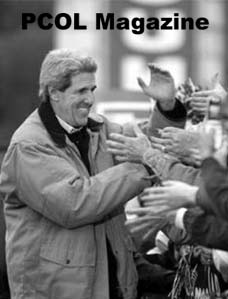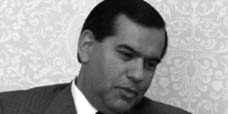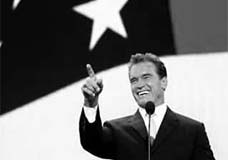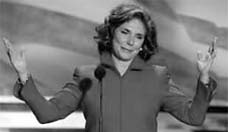
An engineer, physician, educator and jazz dancer, Mae Jemison is keenly aware of the obstacles that women and minorities must overcome to succeed in fields that have long been exclusionary. At 39, she is angrier than she once was about how inherently unfair that is, about how impossibly superb members of those excluded groups are expected to be in order to prove that merit, not entitlement, won them an opportunity
Shooting Star
Former Astronaut Mae Jemison Brings her Message Down to Earth
By Jesse Katz
Illustration by Barry Blitt
It would've been so charmingly naive, this tale Mae Jemison tells of her early celestial dreams, if it weren't also a parable for the spirit that helped make them come true. As fantastical as it sounds, her pioneering journey aboard the space shuttle Endeavour was fueled by a childhood passion for "Star Trek," its made-for-TV adventures stimulating a hunger for real ones in her mind.
Who cared that, in reality, every U.S. astronaut was white and male at the time? She looked no further than the USS Enterprise. After all, right there on the screen, week in and week out, who could miss Lt. Uhura, the starship's stylish, self-assured communications officer -- and a black woman, no less. For little Mae, a child of the '60s, the make-believe image was more potent than any dispiriting fact of real life.
"Images show us possibilities," the Stanford graduate says. "A lot of times, fantasy is what gets us through to reality."
A quarter of a century after Lt. Uhura boldly went where no African American had gone before, her protegee returned the favor. Before blasting into orbit aboard the Endeavour in 1992, Jemison, the first woman of color in space, called actress Nichelle Nichols to thank her for the inspiration. And then she made a promise:
Despite NASA's rigid protocol, Jemison would begin each shift with a salute that only a Trekkie could appreciate. "Hailing frequencies open," she could be heard repeating throughout the eight-day mission.
Now the president of her own consulting firm, its mission to find high-tech salves for the afflictions of developing nations, Dr. Mae Carol Jemison is the Lt. Uhura of her generation. As she prepared to return to Stanford to deliver the university's 105th commencement address June 16, it was with the realization that her own achievements have helped redefine the image of modern-day scientists -- in the real world, not just in space-age fiction.
An engineer, physician, educator and jazz dancer, Jemison is keenly aware of the obstacles that women and minorities must overcome to succeed in fields that have long been exclusionary. At 39, she is angrier than she once was about how inherently unfair that is, about how impossibly superb members of those excluded groups are expected to be in order to prove that merit, not entitlement, won them an opportunity.
"If we can allow some people to be average, how come a minority or a woman who comes into a particular job has to be the absolute cream of the crop?" asked Jemison, who candidly acknowledges that affirmative action helped secure her a spot in Stanford's Class of '77.
But Jemison, in spite of -- or because of -- all the hurdles she has scaled, retains a dreamy sense of confidence. It is the same unbridled imagination that allowed her to envision herself in space at a time when Lt. Uhura, for all her technological prowess, was still better known for performing TV's first interracial kiss. Without dismissing society's obvious inequities, Jemison remains convinced that the only true limits are the ones we impose on ourselves -- or permit others to impose on us. When cynics took aim at another popular TV series, "The Cosby Show," she was deeply pained by the implication that a happy middle-class African American family was somehow the stuff of futuristic fancy.
"Nothing hurts me more than when I run into a little girl or a little boy who asks me how they should keep from being limited because they're black or they grew up poor," she said. "I think a lot of that comes from the images that we provide to them, images that focus on one stereotypic way of life. When a 6- or 7- or 8-year-old child asks me, 'How do you get over this?' that's a question they've been taught to ask."
Sitting in a conference room at her Houston firm, The Jemison Group Inc., she radiates poise: Her sentences are precise and methodical, but she also erupts into bursts of self-deprecating hilarity. Tall and striking, her hair short and natural, she appears refreshingly unadorned -- almost no makeup or jewelry, other than a gold hoop in each ear and a rubber band around her right wrist.
As Jemison is quick to point out, she is far from a one-dimensional NASA-molded, "black Barbie doll." On her shuttle flight, she brought along an Alvin Ailey dance poster, a West African statuette and a Michael Jordan jersey -- artifacts designed to promote the idea that "space is a birthright for all of us on this planet."
It is a view of the world that ultimately left her feeling somewhat confined at NASA, where space missions are built on specialization and training depends on the repetition of narrowly prescribed tasks. "Mae's personality was too big for that," says Homer Hickam, her training manager for the Endeavour mission.
Although he described Jemison's 1993 resignation as amicable, he acknowledged that the space agency was not thrilled to see her go. "NASA had spent a lot of money training her; she also filled a niche, obviously, being a woman of color," says Hickam, now the training manager for NASA's space station efforts. But he added that it would have been counterproductive to stand in her way.
"I see Mae as sort of an all-around ambassador," says Hickam. "She just really wanted to make a connection with the world."
Born in Alabama and raised in Chicago by a carpenter father and schoolteacher mother, young Mae spent her childhood learning to make connections to the world by studying the patterns of stars, flowers, trees, ants -- even pustulant wounds.
"It sounds a little gross, but I was fascinated with pus," she said, recalling a splinter that infected her thumb as a little girl. Like many of her experiences, it became a springboard for exploration. "I ran and showed it to my mother and she was telling me it was pus," Jemison continued, laughing at the memory. "I was like, 'Well, what is that?' And I ended up doing this whole project, reading about pus. My mother always told me to go find out the information myself. She was very directive, in the sense of 'it's your responsibility,' sort of like those people who tell you to go look up a word in the dictionary when you don't know how to spell it."
Even those activities that conformed to more traditional gender roles became tools for discovery. As a girl, Mae was expected to learn how to sew, first stitching clothes for her Barbie dolls, then designing many of her own outfits. It was only later, when she began studying engineering and medicine, that she realized the extent to which her crafts were intertwined. "When I got into surgery, I was struck by how much things were just like sewing," she said. "It taught me a lot about how things are put together, about constructing patterns and doing three-dimensional work in your mind."
Her precociousness put her on a fast track in school, so that she was just 16 when she arrived at Stanford--a university that attracted her, she says only half in jest, because of its back-to-back Rose Bowl victories in the early '70s. Once again, she seemed almost oblivious to the academic and social challenges that might have intimidated a less headstrong student.
"I was naive and stubborn enough that it didn't faze me," she said. "It's not until recently that I realized that 16 was particularly young or that there were even any issues associated with my parents having enough confidence in me to [allow me to] go that far away from home."
Jemison, who received a degree in chemical engineering and fulfilled the requirements for another in Afro-American studies, recalls her Stanford years as "wonderful and very positive," but remembers the sting of a handful of professors who seemed uncomfortable with a young black woman in their classes. Still, she believes those experiences made her a stronger person, launching her on a decade of scholarship and wanderlust, during which she graduated from Cornell Medical College while applying her skills in Cuba, Kenya, Thailand and, later as a Peace Corps medical officer, in Sierra Leone and Liberia.
"She just had a different twist on life," says Jemison's closest friend, Lynda Bradford, who runs a children's program at the Chicago Museum of Science and Industry. "If she saw it and she wanted to experience it, there was no barrier to her achieving it. She felt the world was her laboratory."
Those experiences helped lay the foundation for Jemison's most recent endeavors, both with her for-profit Jemison Group in Houston and with her non-profit Jemison Institute at Dartmouth College, where she is a member of the environmental studies faculty. She is currently at work on Alafiya (meaning "good health" in Yoruba), a satellite-based telecommunications system designed to improve the delivery of health-care information in remote corners of West Africa. She also has teamed up with a South African firm, Suncorp, to develop a solar-energy system capable of storing power for nighttime use and periods of increased demand.
Her blend of social concern and technical know-how make her "one of the most interdisciplinary people you can find," says Ross Virginia, chairman of Dartmouth's environmental studies program. Typically, he said, efforts to improve conditions in developing countries focus on reverting to simpler ways of life. Jemison's work is unique in that she is "designing technology with human needs at heart, getting people with a stake in the outcome involved in the design," Virginia said. Although some of her projects are still in their infancy, he added, "she's a strong, credible voice."
Jemison, who also runs an international science camp called "The Earth We Share," believes her ultimate mission is to democratize technology.
"I think it's so vitally important that all people in this world are involved in the process of discovery," says Jemison, who was named in the 1993 edition of People magazine's "50 Most Beautiful People in the World." At first Jemison thought the distinction was "goofy," but then decided it would serve a greater purpose. "We need to change the image of who does science," she said. "That's important not only for folks who want to go into science, but for the folks who fund science."
Lately, Jemison has been in the public eye for reasons not entirely of her choosing. On Feb. 24, a police officer stopped her for a minor traffic infraction in Nassau Bay, the tiny southeast Houston suburb that has been her home for eight years. After learning that she had an outstanding warrant for an old speeding ticket, the officer pulled out his handcuffs and began placing her under arrest. In a formal complaint, Jemison accused the officer of physically and emotionally mistreating her, twisting her arms and throwing her face down on the pavement. Although the officer was cleared of wrongdoing by his department, Jemison insisted, "A citizen shouldn't be manhandled and abused for a traffic stop."
Jemison's return to Stanford puts her back in a more welcome spotlight.
She admits to feeling a bit weak-kneed about the notion of facing her old professors. But she also acknowledges the responsibilities that come with her achievements, a duty to pass on some of the inspiration that helped catapult her into the
cosmos.
"Public figures can be images," she said. "Images of what other folks can be or how they might live their lives. ST
Jesse Katz is the Houston bureau chief for the Los Angeles Times.





